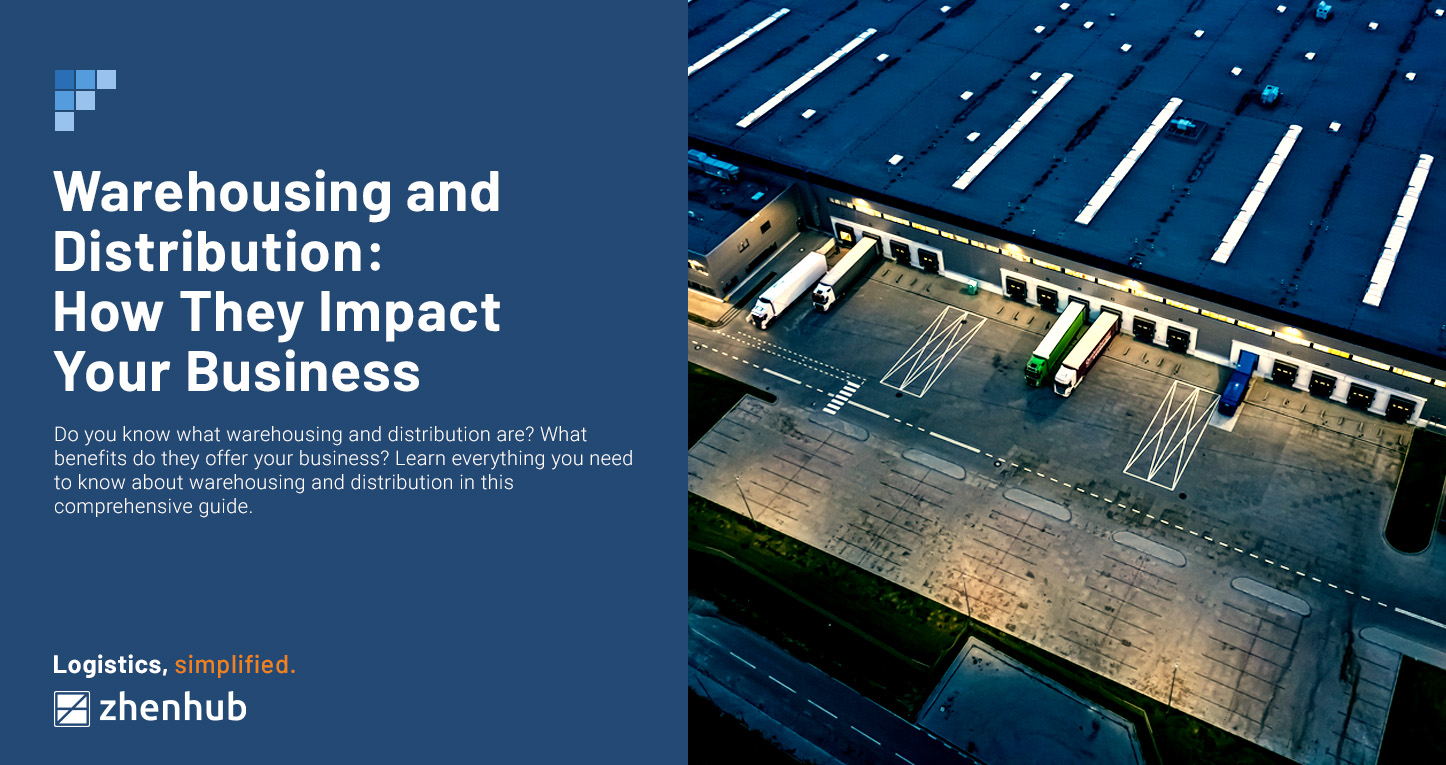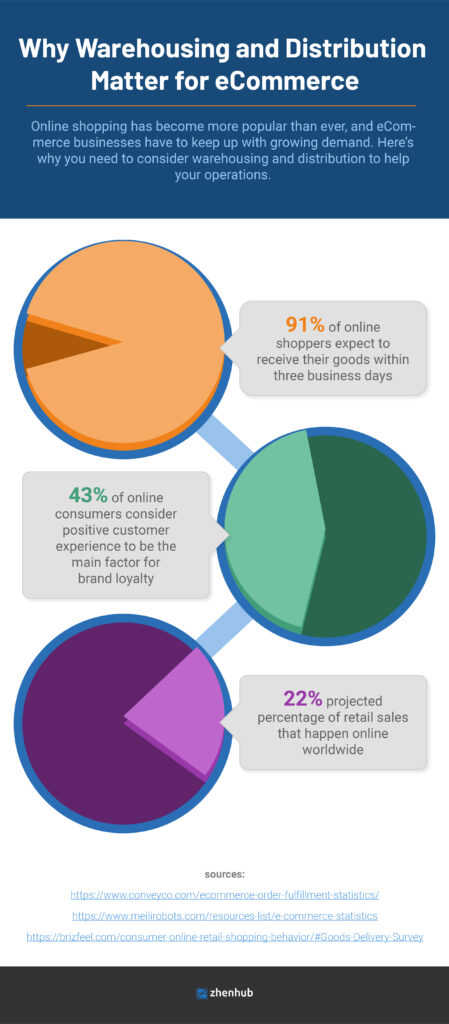
How Warehousing and Distribution Impacts Your Business in 2025
Time to read: 6 minutes
If you’re an eCommerce business, you need to promptly make sure your products get from Point A to B. Warehousing refers to the storage of products, while distribution refers to getting them to customers.
But which one is right for your business? With the evolution of the supply chain in the digital and online age, retailers need to get their products to their customers quickly. Why? More than half of consumers today (over 57%) prefer to shop online, and 91% expect to have goods within three business days.
This article discusses the differences between warehousing and distribution and their importance to your day-to-day operations.
What is Warehousing?
Many of us already know what a warehouse is; it’s usually a large building used for storing materials or products before they are sold or used. But beyond that simple definition, warehousing gives us the idea that it is a planned space with efficient handling and storage of goods and materials.
It sets it apart from regular storage because warehouses carry inventory to sell. As a result, the high volume of products stored there gets constantly moved around quickly. In comparison, storage is more of safekeeping, used by individuals who need the extra space to safely store things for the long term when they no longer can keep them at home.
Here are the advantages of having a well-managed warehousing system:
- Organized Inventory Management – Having all your goods in a centralized location gives you oversight over all your current products.
- Improved Product Processing – Warehouses are often equipped with facilities that efficiently store, pack, and move orders.
- Agile Customer Service – Meet client expectations and fulfill orders faster. It can also reduce errors by keeping your inventory organized and secure. Plus you can deliver warehoused products more quickly than those stored locally, which will increase labor productivity.
- Reliable Risk Management – Warehousing helps with sudden price changes in the market, as you can stockpile products and always have a steady supply.
Running a warehouse is more than just holding inventory and stock. Proper logistics include maximizing space, as capacity is crucial to its utility. Storing things in specific areas can facilitate faster movement and easier access. Receiving new items, storage, and then tracking is part of the warehousing process. Climate control could also be necessary depending on the type of products you hold, such as medicine or food.
When it comes to the different types of warehouses, big retailers such as supermarkets or department stores have different needs compared to smaller businesses or traditional brick-and-mortar stores. For example, they need greater flexibility with distribution centers and storage facilities to accommodate the amount of inventory that is being shipped from these massive corporations every day.
Even small businesses that operate out of the garage can benefit from warehousing. The logistics industry has been expanding, and there are many different options available to fit any company’s needs.
Reorganization is a must when there is a constant flow of goods going in and out of the warehouse. Finally, when it’s time for shipment, staff need to quickly locate items and prepare them for release while making room for new stock.
Warehouses are more than just storage facilities for inventory. They’re also an integral part of any company’s supply chain management. As a result, businesses can cut costs by optimizing purchase strategies and speeding up delivery times to customers through better planning with their warehousing partners.
Warehousing is a great way to store inventory and ship it out more efficiently. Businesses that use warehoused products often have their eCommerce platforms integrated with the system to keep track of what’s inside, It also shows how much was purchased, the date/time certifies all transactions and quickly fulfills customer orders.
A Deep Dive into Distribution
Distribution is an essential part of any business. You can have peace of mind knowing your products are handled with care, moving from the warehouse to your customers. It also plays a part in managing client expectations, providing accurate parcel status and delivery dates.
Moreover, distribution’s importance has grown considerably with today’s global economy. Businesses must employ good distribution practices at all times (and places) to ensure maximum customer satisfaction.
To begin understanding the finer points of distribution, we’ll define the different distribution channels. Distribution channels are the paths by which all goods and services must travel to reach their desired consumers. The channels that a company uses can be short or long, depending on how many intermediaries are involved. Different levels of quality assurance are involved during the movement of goods or services through channels.
Here are different stages or intermediaries that commonly make up a distribution channel:
- Producers – These are manufacturers of goods and are primarily in charge of product availability. They can reach out to distributors to ensure their stock gets out to the market.
- Wholesaler – These businesses buy products in bulk from dealers to directly sell to retailers or other wholesalers.
- Retailers – Supermarkets, department stores, big-box stores, etc., that serve as the contact point between producers and buyers.
- Consumers – The “final-end” of the distribution channel. Individuals who buy goods and services to meet both wants and needs.
A businesses’ goal is to have its products or service reach its intended target market and, of course, make a profit.
Let’s move on to the different distribution channels we can observe in businesses we encounter daily.
- Direct distribution -The manufacturer/producer skips any intermediaries and sells its products directly to the consumer. Businesses that sell niche, luxurious, and perishable goods commonly employ this type of distribution. Examples would include a small neighborhood bakery or iPhones bought from the Apple store.
- Indirect Distribution – Producers outsource their goods or services to wholesalers and retailers, who then act as the intermediaries to bring them to the market. Indirect distribution can be further divided by how many stages the distribution goes through.
- One level channel – Retailers get their goods from a producer and sell them straight to the buyers, e.g., clothes, furniture, toys.
- Two-level channel – Wholesalers make bulk purchases from the producer and then package them separately to sell to retailers. Consumers then buy directly from the retailer. Ideal for larger target markets.
- Three-level channel – Best for high-demand products that are distributed and targeted at large regions. The goods flow from producers through agents who help sell them in their area of responsibility before going to large retailers or homes.
- One level channel – Retailers get their goods from a producer and sell them straight to the buyers, e.g., clothes, furniture, toys.
With e-commerce growing tremendously over the last few years, manufacturers and producers have found a new way to sell their goods. Online marketplaces such as Amazon or Alibaba allow them access into one specific country and across different regions with the Internet. These sites make it easy for companies who would like
to expand internationally while still maintaining control over what they’re selling.
Maximizing Warehousing and Distribution for eCommerce
eCommerce businesses play a prominent role in distribution for the digital age. It’s now easier to have products shipped directly through your homes without having to leave the comfort of your couch. Warehousing and distribution for eCommerce have great opportunities, but there are challenges. Here are some key points that can help you decide your business needs.
- What You’re Selling – Are the products you bring out to the market perishable? How many units do you move daily? Do you serve local customers only, or do you reach out to international clientele? These are the questions you can ask yourself to help you determine a more significant priority:holding and moving stock or getting products out to consumers. A B2B wholesaler that serves several cities in a country might find warehousing a practical and cost-efficient solution. A small online business based at home that holds all its stock at home can enjoy the services of a distribution system that caters to customers beyond their local ZIP code.
- Compatibility with eCommerce Software – Running an online business is more manageable with automated systems and instant messaging. You can serve your customers better if you work with a smart warehouse or distributors that are online 24/7. It keeps tabs on your stock through your phone, and coordinating deliveries on the go means less business downtime. Analytics also provides a closer look at business performance, giving you the insight to make changes and adjustments to your overall strategy.
- Budget for logistics – Most eCommerce retailers have spent 11% of their revenue on logistics in recent years. Evaluate your current storage and shipment solutions concerning your costing. You could end up saving more money, time, and effort if you redirect funds to outsourcing fulfillment via a distribution channel. Or you can get a warehouse to manage your stock for you.
- Creating a Positive Customer Experience – You need to ensure your business can handle customer demand at the end of the day. Warehousing and distribution are viable solutions depending on your business scale. Create a seamless experience for customers building trust through transparency and reliability.

Warehousing and distribution are critical components of any successful eCommerce business. Understanding their different aspects can make your operations run more smoothly and efficiently. Doing logistics the right way can mean faster shipping and deeper customer loyalty. It’s essential given consumer expectations of receiving goods on time. Sixty-two percent (62%) of online shoppers consider fast shipping speeds to contribute to a positive customer experience.
Transparency keeps customers in the loop, so you know your items stay in the cart. When your Inventory management and organization are automated and updated, you can also spend more time on other business operations, such as marketing. It’s exciting to see your business grow, and with that, you need to keep up with modernized strategies to increase your bottom line and keep customers happy.
ZhenHub offers comprehensive logistics software solutions for businesses of all sizes. Contact us now or request a free quote to discover how to accelerate your growth!